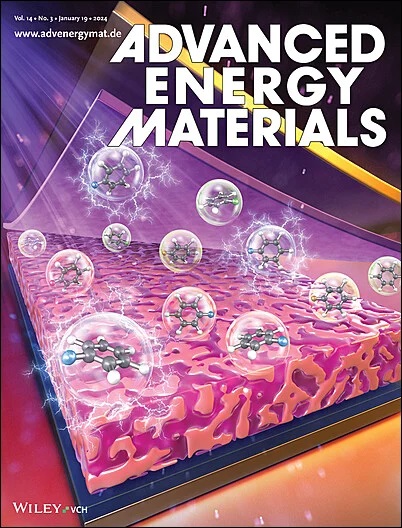异核双原子位点的固有电子转移促进选择性电催化二氧化碳还原
IF 24.4
1区 材料科学
Q1 CHEMISTRY, PHYSICAL
引用次数: 0
摘要
异核双原子催化剂(HNDACs)中的金属-金属(M1-M2)相互作用极大地优化了活性位点的电子特性,从而促进了电催化反应动力学。然而,这些 M1-M2 双原子位点的调节机制仍不清楚。本文揭示了铁锌双原子位点的内在电子传递,以促进电催化二氧化碳还原(ECO2R)为一氧化碳(CO)的反应。铁和锌中心的电负性差异诱导了特定的电子从锌转移到铁,从而调节了活性锌位点的电子结构,优化了这些位点上 CO2 到 CO 的转化反应途径。与单原子铁/锌催化剂(FeNC 和 ZnNC)相比,FeZn HNDAC(FeZnNC)在典型的氢电池体系中表现出更优越的 ECO2R 性能,FeZnNC 上的最大 CO 部分电流密度分别达到 FeNC 和 ZnNC 上的 3.3 倍和 1.8 倍以上。更重要的是,在强酸性介质(pH = 1)中,FeZnNC 在 100-400 mA cm-2 的电流密度范围内实现了超过 94% 的 CO 法拉第效率。这项工作揭示了异核二原子位点的内在电子传递,为合理设计高性能 HNDACs 实现工业电催化提供了新的见解。本文章由计算机程序翻译,如有差异,请以英文原文为准。

Intrinsic Electron Transfer in Heteronuclear Dual-Atom Sites Facilitates Selective Electrocatalytic Carbon Dioxide Reduction
The metal–metal (M1–M2) interactions in heteronuclear dual-atom catalysts (HNDACs) significantly optimize the electronic properties of the active sites, resulting in the promotion of the reaction kinetics in electrocatalysis. However, the regulation mechanisms in these M1–M2 dual-atom sites still remain unclear. Herein, the intrinsic electron transfer in Fe–Zn dual-atom sites are revealed for facilitating electrocatalytic carbon dioxide reduction (ECO2R) to carbon monoxide (CO). The electronegativity difference between the Fe and Zn centers induces the specific electron transfer from Zn to Fe, which regulates the electron structures of the active Zn sites, leading to the optimized reaction pathway of CO2-to-CO conversion on these sites. The Fe–Zn HNDAC (FeZnNC) exhibits superior ECO2R performances than the single-atom Fe/Zn catalysts (FeNC and ZnNC) in the typical H-cell system, the maximum CO partial current density on FeZnNC reaches more than 3.3 and 1.8 folds of those on FeNC and ZnNC, respectively. More importantly, in a strongly acidic medium (pH = 1), FeZnNC achieves CO Faradaic efficiencies greater than 94% in the current density range of 100–400 mA cm−2. This work uncovers the intrinsic electron transfer at the heteronuclear diatomic sites, providing new insights for the rational design of high-performance HNDACs toward industrial electrocatalysis.
求助全文
通过发布文献求助,成功后即可免费获取论文全文。
去求助
来源期刊

Advanced Energy Materials
CHEMISTRY, PHYSICAL-ENERGY & FUELS
CiteScore
41.90
自引率
4.00%
发文量
889
审稿时长
1.4 months
期刊介绍:
Established in 2011, Advanced Energy Materials is an international, interdisciplinary, English-language journal that focuses on materials used in energy harvesting, conversion, and storage. It is regarded as a top-quality journal alongside Advanced Materials, Advanced Functional Materials, and Small.
With a 2022 Impact Factor of 27.8, Advanced Energy Materials is considered a prime source for the best energy-related research. The journal covers a wide range of topics in energy-related research, including organic and inorganic photovoltaics, batteries and supercapacitors, fuel cells, hydrogen generation and storage, thermoelectrics, water splitting and photocatalysis, solar fuels and thermosolar power, magnetocalorics, and piezoelectronics.
The readership of Advanced Energy Materials includes materials scientists, chemists, physicists, and engineers in both academia and industry. The journal is indexed in various databases and collections, such as Advanced Technologies & Aerospace Database, FIZ Karlsruhe, INSPEC (IET), Science Citation Index Expanded, Technology Collection, and Web of Science, among others.
 求助内容:
求助内容: 应助结果提醒方式:
应助结果提醒方式:


